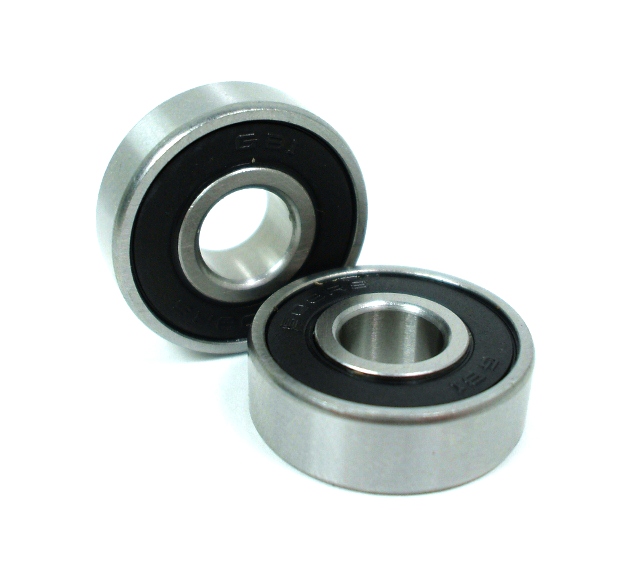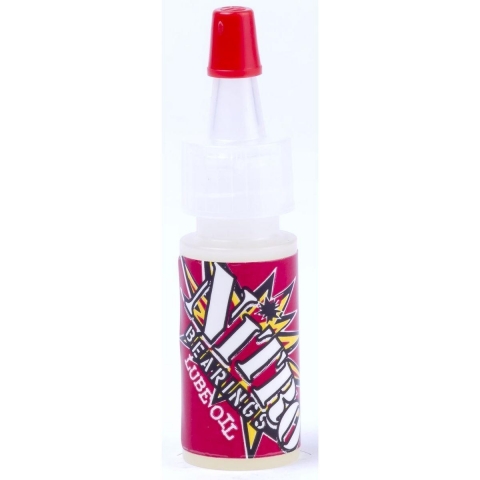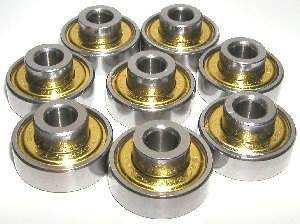- No products in the cart.
Bearings: A Semi-Factual Analysis
Bearings: A semi-factual analysis
Do you have Reds?
What are you fastest bearings?
Whats better, built in or not?
What are you fastest bearings?
Whats better, built in or not?
Bearings can be misleading and difficult to wrap your head around when shopping for new ones. Check this if your brain has been itching, hopefully we can dispell some myths and clear up some haziness.
Ball bearings could easily be called the foundation of modern society – they keep machines running, cars driving, boats afloat and full of hoes. Our bearing in question was patented in 1903 by a Brit named Robert Conrad, who probably didn’t realize he had just fueled the impending industrial revolution in a major way. The bearing design utilizes two circular “races” connected by a cylindrical bore, which holds the spinning spherical balls caged by either nylon or steel, which rotate the races around the stationary bore, which allowed things to spin like never before (or at all).

Standard 608 bearings.
Years passed, facts were glossed over, and we arrived at skateboarding. Unsafe bearings are one of the cliches of the early days of sidewalk surfing – as any O.G. will tell you, the best way to get down your local slide hill “back in the day” was to straight-line it and pray. If you hit a pebble your ball bearings would spray out unimpeded by shields and send your banana board with steel wheels, as well as yourself, flying through the air. Nowadays you can order skateboard bearings (the standard size is 608 unless you ride rollerblades, Kryptonics, or unsightly 10mm axles) from China for less than a buck a bearing – so why go buy them at your local skateshop? Great question! Well, there is this little thing we have the ABEC rating. This, contrary to a litany of popular beliefs, is basically a rating of tolerances and NOT quality, contrary to what engineers will tell you. That is to say, the lower the ABEC rating from 1-9 (excluding even numbers), the greater the allowable margin of error. These ratings are often neglegable to a skaters needs. We try to disregard the “precision” of a bearing in favor of the quality of the bearing. An abec 5 bearing that stands up to months of abuse presents a much better value to skaters than an abec 9 bearings that develops slop after an hour of riding.
There are many other standards and variables to be found in this niche market. Unlike CNC’d downhill trucks or aftermarket bushings, ball bearings can be found in many everyday devices which make them very accessable. The materials vary, generally between Steel, Nylon and Ceramic components which result in different levels of friction under loads. The most common configuration is steel races and balls with nylon shields and cages to keep out dirt and grit. You can also purchase bearings with ceramic balls that are much less prone to rust(the races are often still steel and can rust) and spin better because the balls are guaranteed to be perfectly spherical, but are expensive and require much more maintenance compared to their metal brethren. Ceramic also doesn’t conduct nearly as much heat as much as steel, which makes them ideal for a dedicated speed setup. Steel cages can also be employed as opposed to nylon, but these have more friction to the balls and are generally of a lower quality. Steel cages can also be used for death matches, but Flatspot does not condone those.

Just one example of the many lubricants on the market.
Lube is also important to the health and maintenance of the bearing, and is available a variety of oils, greases and bodily fluids(not recommended). There are a plethora of skate-specific lubes on the market, or classic 3-in-1 from Canadian Tire will work as well. Stay away from anything that is designed to do anything but lubricate(WD40 is a big no no). If your bearings get wet, spin them out when you get home and re-lube them. You and your bearings will be fine.
Another practice consitered menial by some is the use of bearing spacers and speed-rings. The basic purpose of this combonation is to make one solid component around the axle, and reduce wear on the bearings. The speed rings prevent the axle nuts and hanger face from rubbing on the shields, which creates friction and heat. Essentially, the spacer helps the inner and outer races of your bearinsg to stay aligned and side-load down. This keeps the wheel from “chattering” during a slide, which makes going sideways on a skateboard easier and more fun. Not so menial after all!

The built-in style of bearing is a popular solution to this quandry, consolidating 20 odd pieces into 8 identical bearings. The spacers and speed rings are part of each bearing (each inner race has an extended “half spacer”), meaning you have less to lose when changing wheels.
So that’s bearings in a nutshell. ABEC rating means something(but not enough to cause legitimate concern), ceramics are expensive (duh!) and you should probably get some brightly colored, well machined spacers and speed rings so your bearings last, AND you don’t lose them. Any fluid with decent viscosity will keep ’em spinning fast and smooth, and as with anything else, if you have to ask the price, you can’t afford it.
Enough computer for one day, go skate.
From Chinatown with love.


RECENT COMMENTS